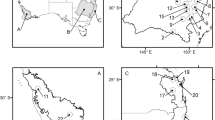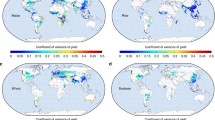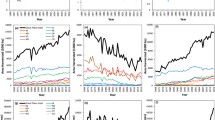Abstract
There is increasing evidence that climate change is impacting not just total amounts of precipitation, but its temporal dynamics as well. While previous studies have identified the importance that the temporal distribution of daily rainfall has on crop production, climate models often do not represent these distributions consistently with observed trends. The objectives of this study are to (1) evaluate the relationship between rainfall variability and yields for economically important crops in the upper Southeastern United States and (2) assess the potential impact that incorporating observed trends in rainfall variability has on yield projections under future climate change. This study develops statistical models of historic crop yields for five crops, finding that an explanatory variable related to daily rainfall variability, the wet-day Gini coefficient (GC), has a statistically significant negative relationship with crop yields in all cases. These models are then used to estimate the impacts of climate change using an ensemble of downscaled general circulation model (GCM) projections and scenarios that include a continuation of observed GC trends. Most downscaled GCMs evaluated do not project changes in GC consistent with observed trends, and scenarios that assume a continuation of observed trends result in projected yields that are up to 5.8% lower than those directly based on GCM projections. While additional research is needed in the climate science community to better understand how rainfall variability may change in the future, this should be mirrored in the impacts community so that agricultural impact assessments incorporate these potentially important changes.


Similar content being viewed by others
References
Allan RP, Soden BJ (2008) Atmospheric warming and the amplification of precipitation extremes. Science 321:1481–1484. https://doi.org/10.1126/science.1160787
Auffhammer M, Ramanathan V, Vincent JR (2012) Climate change, the monsoon, and rice yield in India. Clim Chang 111:411–424. https://doi.org/10.1007/s10584-011-0208-4
Baigorria GA, Jones JW (2010) GiST: a stochastic model for generating spatially and temporally correlated daily rainfall data. J Clim 23:5990–6008. https://doi.org/10.1175/2010JCLI3537.1
Bates D, Maechler M, Bolker B, et al (2018) lme4: linear mixed-effects models using “Eigen” and S4 (version 1.1-19)
Bi D, Dix M, Marsland S et al (2013) The ACCESS coupled model: description, control climate and evaluation. Aust Meteorol Oceanogr J 63:41–64. https://doi.org/10.22499/2.6301.004
Burke M, Emerick K (2016) Adaptation to climate change: evidence from US agriculture. Am Econ J Econ Policy 8:106–140. https://doi.org/10.1257/pol.20130025
Cammarano D, Rivington M, Matthews KB et al (2017) Implications of climate model biases and downscaling on crop model simulated climate change impacts. Eur J Agron 88:63–75. https://doi.org/10.1016/j.eja.2016.05.012
Daly C, Halbleib M, Smith JI et al (2008) Physiographically sensitive mapping of climatological temperature and precipitation across the conterminous United States. Int J Climatol 28:2031–2064. https://doi.org/10.1002/joc.1688
Davis KF, Chhatre A, Rao ND et al (2019) Sensitivity of grain yields to historical climate variability in India. Environ Res Lett 14:064013. https://doi.org/10.1088/1748-9326/ab22db
Demirel MC, Moradkhani H (2016) Assessing the impact of CMIP5 climate multi-modeling on estimating the precipitation seasonality and timing. Clim Chang 135:357–372. https://doi.org/10.1007/s10584-015-1559-z
Dittus AJ, Karoly DJ, Lewis SC et al (2016) A multiregion model evaluation and attribution study of historical changes in the area affected by temperature and precipitation extremes. J Clim 29:8285–8299. https://doi.org/10.1175/JCLI-D-16-0164.1
Donat MG, Alexander LV, Yang H et al (2013) Updated analyses of temperature and precipitation extreme indices since the beginning of the twentieth century: the HadEX2 dataset. J Geophys Res Atmos 118:2098–2118. https://doi.org/10.1002/jgrd.50150
Donner LJ, Wyman BL, Hemler RS et al (2011) The dynamical core, physical parameterizations, and basic simulation characteristics of the atmospheric component AM3 of the GFDL global coupled model CM3. J Clim 24:3484–3519. https://doi.org/10.1175/2011JCLI3955.1
Dufresne JL, Foujols MA, Denvil S, et al (2013) Climate change projections using the IPSL-CM5 Earth System Model: from CMIP3 to CMIP5. Clim Dyn 40:2123–2165. doi: https://doi.org/10.1007/s00382-012-1636-1
Easterling DRK (2017) Chapter 7: precipitation change in the United States. In: Climate science special report: fourth National Climate Assessment. U.S. Global Change Research Program
Fishman R (2016) More uneven distributions overturn benefits of higher precipitation for crop yields. Environ Res Lett 11:024004. https://doi.org/10.1088/1748-9326/11/2/024004
Flato G, Marotzke J, Abiodun B et al (2014) Evaluation of climate models. In: Climate change 2013: the physical science basis. Contribution of working group I to the fifth assessment report of the Intergovernmental Panel on Climate Change. Cambridge University Press, Cambridge, pp 741–866
Gleick PH (1986) Methods for evaluating the regional hydrologic impacts of global climatic changes. J Hydrol 88:97–116. https://doi.org/10.1016/0022-1694(86)90199-X
Guo D, Westra S, Maier HR (2018) An inverse approach to perturb historical rainfall data for scenario-neutral climate impact studies. J Hydrol 556:877–890. https://doi.org/10.1016/j.jhydrol.2016.03.025
Hawkins E, Osborne TM, Ho CK, Challinor AJ (2013) Calibration and bias correction of climate projections for crop modelling: an idealised case study over Europe. Agric For Meteorol 170:19–31. https://doi.org/10.1016/j.agrformet.2012.04.007
Hoerling M, Eischeid J, Perlwitz J et al (2016) Characterizing recent trends in U.S. heavy precipitation. J Clim 29:2313–2332. https://doi.org/10.1175/JCLI-D-15-0441.1
Homer CG, Dewitz JA, Yang L et al (2015) Completion of the 2011 National Land Cover Database for the conterminous United States-representing a decade of land cover change information. Photogramm Eng Remote Sens 81:345–354
Ines AVM, Hansen JW, Robertson AW (2011) Enhancing the utility of daily GCM rainfall for crop yield prediction. Int J Climatol 31:2168–2182. https://doi.org/10.1002/joc.2223
Knutti R, Masson D, Gettelman A (2013) Climate model genealogy: generation CMIP5 and how we got there. Geophys Res Lett 40:1194–1199. https://doi.org/10.1002/grl.50256
Lobell DB (2017) Comparing estimates of climate change impacts from processbased and statistical crop models. Env Res Lett 13
Lobell DB, Schlenker W, Costa-Roberts J (2011) Climate trends and global crop production since 1980. Science 333:616–620. https://doi.org/10.1126/science.1204531
Mearns LO, Rosenzweig C, Goldberg R (1996) The effect of changes in daily and interannual climatic variability on CERES-wheat: a sensitivity study. Clim Chang 32:257–292. https://doi.org/10.1007/BF00142465
Milly PCD, Malyshev SL, Shevliakova E et al (2014) An enhanced model of land water and energy for global hydrologic and earth-system studies. J Hydrometeorol 15:1739–1761. https://doi.org/10.1175/JHM-D-13-0162.1
Min S-K, Zhang X, Zwiers FW, Hegerl GC (2011) Human contribution to more-intense precipitation extremes. Nature 470:378–381. https://doi.org/10.1038/nature09763
Moore FC, Baldos ULC, Hertel T (2017) Economic impacts of climate change on agriculture: a comparison of process-based and statistical yield models. Environ Res Lett 12:065008. https://doi.org/10.1088/1748-9326/aa6eb2
Olesen J, Jensen T, Petersen J (2000) Sensitivity of field-scale winter wheat production in Denmark to climate variability and climate change. Clim Res 15:221–238. https://doi.org/10.3354/cr015221
Pendergrass AG, Knutti R (2018) The uneven nature of daily precipitation and its change. Geophys Res Lett 45:11,980–11,988. https://doi.org/10.1029/2018GL080298
Rajah K, O’Leary T, Turner A et al (2014) Changes to the temporal distribution of daily precipitation: changing precipitation temporal patterns. Geophys Res Lett 41:8887–8894. https://doi.org/10.1002/2014GL062156
Richter GM, Semenov MA (2005) Modelling impacts of climate change on wheat yields in England and Wales: assessing drought risks. Agric Syst 84:77–97. https://doi.org/10.1016/j.agsy.2004.06.011
Roberts MJ, Braun NO, Sinclair TR et al (2017) Comparing and combining process-based crop models and statistical models with some implications for climate change. Environ Res Lett 12:095010. https://doi.org/10.1088/1748-9326/aa7f33
Roque-Malo S, Kumar P (2017) Patterns of change in high frequency precipitation variability over North America. Sci Rep 7. https://doi.org/10.1038/s41598-017-10827-8
Rosenzweig C, Elliott J, Deryng D et al (2014) Assessing agricultural risks of climate change in the 21st century in a global gridded crop model intercomparison. Proc Natl Acad Sci 111:3268–3273. https://doi.org/10.1073/pnas.1222463110
Rowhani P, Lobell DB, Linderman M, Ramankutty N (2011) Climate variability and crop production in Tanzania. Agric For Meteorol 151:449–460. https://doi.org/10.1016/j.agrformet.2010.12.002
Royé D, Martin-Vide J (2017) Concentration of daily precipitation in the contiguous United States. Atmospheric Res 196:237–247. https://doi.org/10.1016/j.atmosres.2017.06.011
Schauberger B, Archontoulis S, Arneth A et al (2017) Consistent negative response of US crops to high temperatures in observations and crop models. Nat Commun 8:13931. https://doi.org/10.1038/ncomms13931
Schlenker W, Roberts MJ (2009) Nonlinear temperature effects indicate severe damages to US crop yields under climate change. Proc Natl Acad Sci 106:15594–15598
Semenov MA, Donatelli M, Stratonovitch P et al (2010) ELPIS: a dataset of local-scale daily climate scenarios for Europe. Clim Res 44:3–15. https://doi.org/10.3354/cr00865
Sheffield J, Goteti G, Wood EF (2006) Development of a 50-year high-resolution global dataset of meteorological forcings for land surface modeling. J Clim 19:3088–3111. https://doi.org/10.1175/JCLI3790.1
Tebaldi C, Knutti R (2007) The use of the multi-model ensemble in probabilistic climate projections. Philos Trans R Soc Math Phys Eng Sci 365:2053–2075
Tebaldi C, Hayhoe K, Arblaster JM, Meehl GA (2006) Going to the extremes. Clim Chang 79:185–211. https://doi.org/10.1007/s10584-006-9051-4
Thrasher B, Maurer EP, McKellar C, Duffy PB (2012) Technical note: bias correcting climate model simulated daily temperature extremes with quantile mapping. Hydrol Earth Syst Sci 16:3309–3314. https://doi.org/10.5194/hess-16-3309-2012
Thrasher B, Xiong J, Wang W et al (2013) Downscaled climate projections suitable for resource management. EOS Trans Am Geophys Union 94:321–323
Troy TJ, Kipgen C, Pal I (2015) The impact of climate extremes and irrigation on US crop yields. Environ Res Lett 10:054013. https://doi.org/10.1088/1748-9326/10/5/054013
United States Department of Agriculture (2018) USDA National Agricultural Statistics Service Quick Stats database. https://quickstats.nass.usda.gov/. Accessed 18 May 2018
USDA National Agricultural Statistic Service (2014) 2012 census of agriculture: farm and ranch irrigation survey (2013)
Volodin EM, Dianskii NA, Gusev AV (2010) Simulating present-day climate with the INMCM4.0 coupled model of the atmospheric and oceanic general circulations. Izv Atmos Ocean Phys 46:414–431. https://doi.org/10.1134/S000143381004002X
Westra S, Alexander LV, Zwiers FW (2012) Global increasing trends in annual maximum daily precipitation. J Clim 26:3904–3918. https://doi.org/10.1175/JCLI-D-12-00502.1
Wilby RL, Dessai S (2010) Robust adaptation to climate change. Weather 65:180–185. https://doi.org/10.1002/wea.543
Wolf J, Evans L, Semenov M et al (1996) Comparison of wheat simulation models under climate change. I. Model calibration and sensitivity analyses. Clim Res 7:253–270. https://doi.org/10.3354/cr007253
Zhao C, Liu B, Piao S et al (2017) Temperature increase reduces global yields of major crops in four independent estimates. Proc Natl Acad Sci 114:9326–9331. https://doi.org/10.1073/pnas.1701762114
Zuur AF, Ieno EN, Elphick CS (2010) A protocol for data exploration to avoid common statistical problems. Methods Ecol Evol 1:3–14. https://doi.org/10.1111/j.2041-210X.2009.00001.x
Acknowledgments
I would like to thank Mitchell Paoletti and Drew Ellis for their help and perspective on this research.
Funding
This research was supported by Hatch project VA-160078 from the USDA National Institute of Food and Agriculture.
Author information
Authors and Affiliations
Corresponding author
Additional information
Publisher’s note
Springer Nature remains neutral with regard to jurisdictional claims in published maps and institutional affiliations.
Rights and permissions
About this article
Cite this article
Shortridge, J. Observed trends in daily rainfall variability result in more severe climate change impacts to agriculture. Climatic Change 157, 429–444 (2019). https://doi.org/10.1007/s10584-019-02555-x
Received:
Accepted:
Published:
Issue Date:
DOI: https://doi.org/10.1007/s10584-019-02555-x




